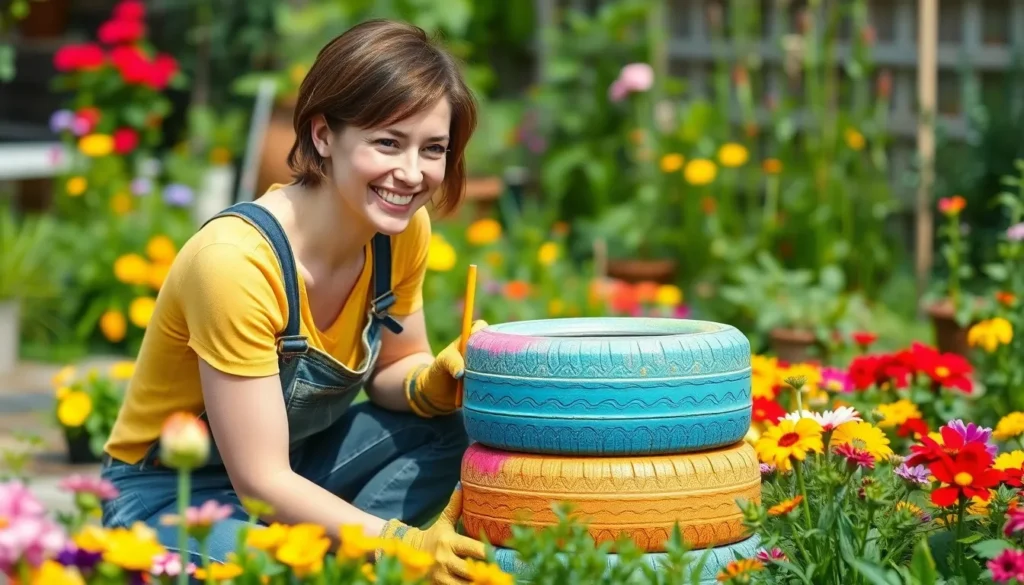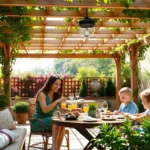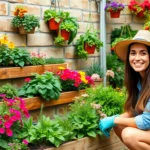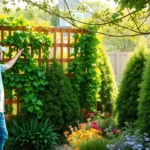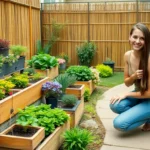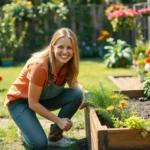We’re living in an era where sustainability meets creativity and garden upcycling has become the perfect solution for eco-conscious gardeners looking to transform their outdoor spaces without very costly. Instead of tossing those old household items into the trash we can give them new life as functional garden treasures that add character and charm to our landscapes.
Garden upcycling isn’t just about being environmentally friendly – it’s about unleashing our imagination to create unique planters containers and decorative elements that can’t be found in any store. From converting worn-out boots into whimsical flower pots to transforming broken furniture into stunning garden focal points the possibilities are endless.
We’ll explore practical and inspiring ways to repurpose everyday items into garden gold. These creative answers will help us reduce waste save money and develop a truly personalized outdoor sanctuary that reflects our style while supporting sustainable living practices.
Transform Old Tires Into Creative Garden Planters
Discarded tires offer incredible potential for creating functional garden planters that combine sustainability with style. We can transform these rubber resources into stunning garden features that serve multiple purposes in our outdoor spaces.
Stack Tires for Vertical Herb Gardens
Stacking tires vertically creates space-efficient herb gardens perfect for small yards or patios. We arrange three to four tires in a pyramid formation, filling each level with quality potting soil and drainage materials. This method allows us to grow different herbs like basil, oregano, parsley, and thyme in separate tiers while maximizing growing space.
Proper drainage becomes essential when building tire towers for herb cultivation. We drill several quarter-inch holes around the bottom tire’s circumference to prevent water accumulation. Adding a layer of gravel or broken pottery pieces in each tire’s base ensures excellent drainage for healthy root development.
Positioning tire herb gardens strategically optimizes plant growth and accessibility. We place these vertical planters near kitchen windows or outdoor cooking areas for convenient harvesting. The black rubber material absorbs heat effectively, creating warm growing conditions that many Mediterranean herbs prefer.
Paint Tires for Colorful Flower Displays
Painting tires with weather-resistant exterior paint creates vibrant planters that brighten any garden space. We use latex or acrylic paints specifically designed for outdoor use, applying primer first to ensure proper paint adhesion. Bright colors like turquoise, coral, yellow, and lime green work exceptionally well for creating eye-catching displays.
Creative painting techniques transform plain tires into artistic garden features. We apply geometric patterns, stripes, polka dots, or even stenciled designs to create unique planters. Metallic spray paints in gold, silver, or copper add sophisticated touches that complement modern garden aesthetics.
Selecting appropriate flowers enhances painted tire planters’ visual impact. We plant colorful annuals like petunias, marigolds, impatiens, and begonias that complement the tire’s painted finish. Trailing varieties such as ivy geraniums or bacopa create beautiful cascading effects that soften the tire’s industrial appearance.
Create Tire Swings for Garden Entertainment
Converting tires into swings adds recreational elements that transform gardens into family-friendly spaces. We secure heavy-duty rope or chains to sturdy tree branches capable of supporting at least 300 pounds of weight. Safety considerations include checking branch integrity and maintaining proper ground clearance of 8-10 inches.
Installing tire swings requires exact hardware and positioning for optimal safety and enjoyment. We use galvanized eye bolts, washers, and nuts rated for outdoor use, drilling pilot holes to prevent wood splitting. The swing should hang at least 6 feet from any structures, fences, or other obstacles to ensure safe operation.
Decorating tire swings creates personalized playground equipment that matches garden themes. We paint swings in bright colors or apply weather-resistant decals featuring favorite characters or patterns. Adding foam padding or cushions increases comfort levels, making these recycled playground features more appealing for extended use.
Repurpose Wooden Pallets for Garden Storage Solutions
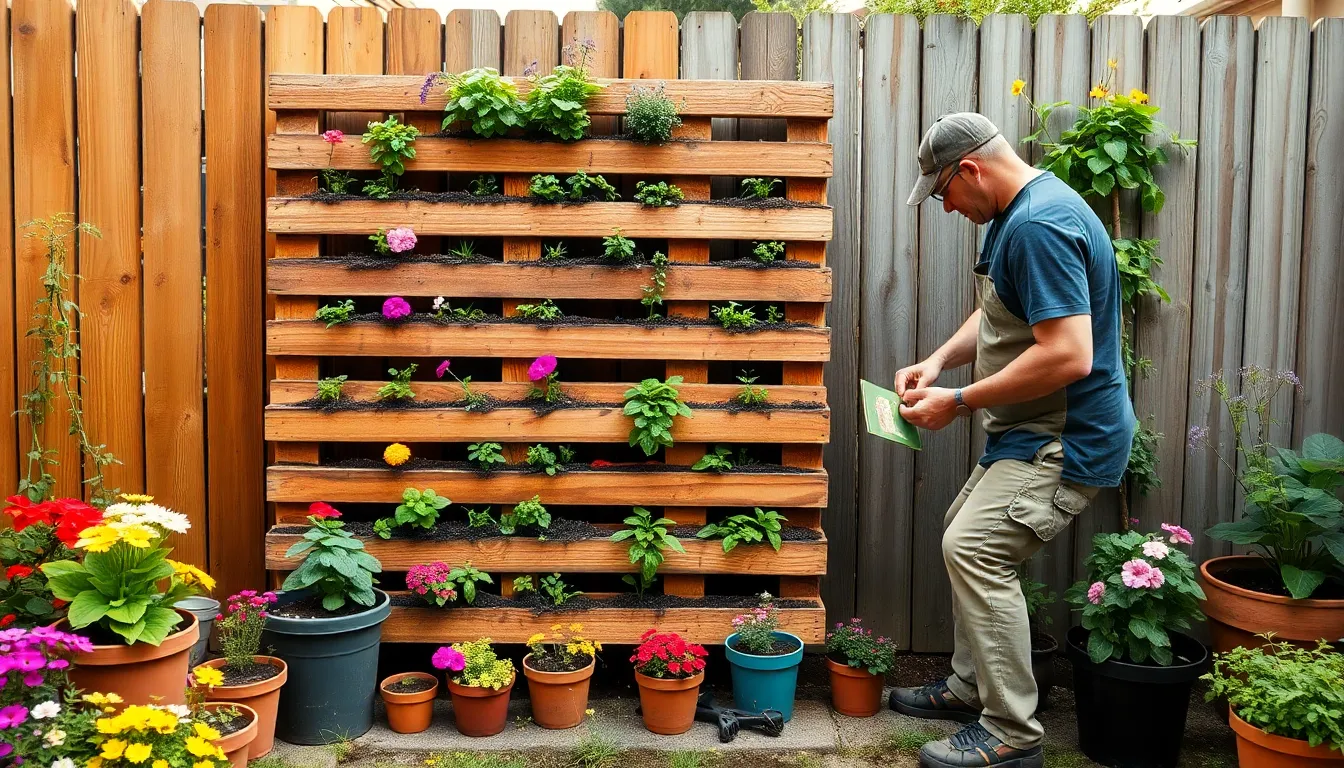
Wooden pallets offer gardeners an incredible opportunity to create functional storage while embracing sustainable upcycling practices. We can transform these readily available materials into organized garden spaces that maximize both efficiency and charm.
Build Vertical Pallet Gardens for Small Spaces
Vertical pallet gardens maximize growing space when we’re working with limited yard areas or balconies. Standing a pallet upright creates the foundation for an impressive green wall that can accommodate flowers, herbs, or vegetables. We fill the slats with soil or insert planter boxes between the wooden spaces to create multiple growing levels.
Space optimization becomes effortless with this vertical approach to container gardening. Urban gardeners particularly benefit from this technique since it transforms unused wall space into productive growing areas. Balcony gardens gain dramatic visual impact when we position these vertical structures against railings or apartment walls.
Growing versatility expands as we customize each pallet section for different plant types. Herbs thrive in the upper sections where drainage is optimal, while trailing plants create cascading effects from lower compartments. We can even combine decorative flowers with edible plants to create both beautiful and functional garden displays.
Create Pallet Compost Bins for Organic Waste
Pallet compost bins provide essential airflow that traditional composting containers often lack. We arrange three or four pallets into a box configuration, allowing organic kitchen scraps and garden waste to decompose efficiently. The natural gaps between pallet slats ensure proper ventilation throughout the composting process.
Construction simplicity makes these bins accessible to gardeners of all skill levels. Basic assembly requires minimal tools, and we can customize the size based on our composting needs. Corner brackets or simple wire connections secure the pallets while maintaining the structural integrity needed for heavy organic materials.
Sustainable gardening practices flourish when we convert waste into nutrient rich soil amendments. These compost systems handle vegetable scraps, grass clippings, and fallen leaves while reducing household waste significantly. We’re essentially creating a closed loop system that transforms discarded materials into valuable garden resources.
Design Pallet Tool Storage Racks
Tool organization transforms when we convert pallets into customized storage racks. Attaching hooks or nails to the pallet slats creates designated spots for rakes, shovels, trowels, and other essential gardening equipment. We keep tools off the ground while ensuring easy access during busy gardening sessions.
Vertical wall placement maximizes storage efficiency in garden sheds, garages, or along fence lines. Mounting pallets securely to existing structures creates instant organization without consuming valuable floor space. We can position these racks at convenient heights for different family members to access tools comfortably.
Customization options expand as we modify pallets to accommodate exact tool collections. Adding small shelves between slats creates space for seed packets, gloves, and smaller hand tools. Weather resistant finishes protect the wood while we maintain an attractive appearance that complements our garden’s overall aesthetic.
Convert Plastic Bottles Into Functional Garden Tools

Plastic bottles offer endless possibilities for creating practical garden tools that help us maintain our outdoor spaces while reducing waste. We can transform these everyday containers into essential gardening equipment with just a few simple modifications.
Make Self-Watering Planters from Soda Bottles
Creating a self-watering system from soda bottles provides consistent moisture for our plants without daily monitoring. We cut the bottom off a standard soda bottle and flip the top portion upside down to create a reservoir system. Placing the inverted bottle neck into the soil of a larger pot allows water to seep gradually into the growing medium. Filling the bottle reservoir with water ensures our plants receive steady hydration over several days, making this perfect for weekend getaways or busy schedules.
Positioning the bottle system requires inserting the neck approximately 2-3 inches into the soil for optimal water transfer. We can adjust the flow rate by creating small holes in the bottle cap using a heated nail or drill bit.
Create Hanging Gardens with Milk Jugs
Transforming milk jugs into hanging planters maximizes our vertical growing space while recycling these sturdy containers. We clean the jugs thoroughly and cut strategic openings in the sides to create planting pockets for herbs or small vegetables. Attaching strong rope or chain through the handle creates a secure hanging system that supports the weight of soil and mature plants.
Drilling drainage holes in the bottom prevents waterlogging and root rot in our hanging gardens. We can create multiple planting levels by hanging jugs at different heights, forming cascading garden displays that use fence posts or pergola structures effectively.
Build Automatic Watering Systems
Constructing automatic watering systems from plastic containers eliminates the guesswork from irrigation scheduling. We drill precise holes in the bottom of clean plastic bottles or containers to control water flow rates. Installing these reservoirs near plant root zones ensures targeted watering that reduces water waste and promotes healthy growth.
Adjusting hole sizes allows us to customize drip rates for different plant types – smaller holes for succulents and larger ones for thirsty vegetables. We can connect multiple bottle systems with tubing to create comprehensive irrigation networks that cover entire garden beds with minimal maintenance required.
Upcycle Old Furniture for Outdoor Garden Decor
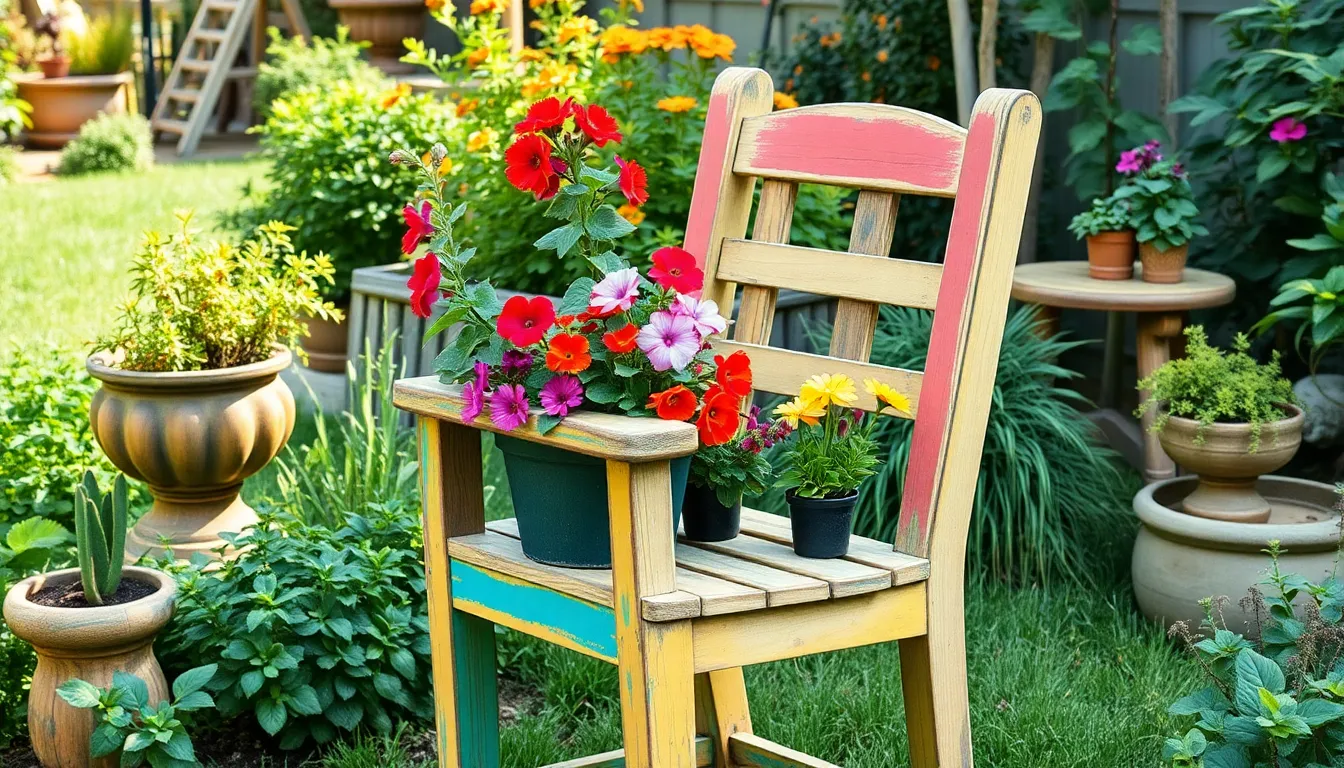
We’ve discovered that worn furniture pieces possess incredible potential for garden transformation. Old chairs, dressers, and tables become stunning outdoor features when we apply creative upcycling techniques.
Transform Chairs into Unique Planter Stands
Chairs serve as exceptional plant stands when we attach planters or pots to their seats and arms. We can secure medium-sized containers directly onto chair seats using heavy-duty adhesive or screws for permanent installations. Armrests provide perfect mounting points for smaller hanging baskets or decorative pots.
Wooden chairs work best for this project since they’re easier to modify and naturally weather-resistant when treated properly. We recommend using outdoor wood stain or paint to protect the furniture from moisture and UV damage. Metal chairs also create striking displays when we add rust-resistant coating before attaching planters.
Convert Dressers into Multi-Level Gardens
Dressers transform into spectacular multi-level gardens when we remove their drawers and convert the openings into planter compartments. Each drawer space becomes a separate growing zone perfect for herbs, flowers, or small vegetables. We can line each compartment with industry fabric and add drainage holes to prevent water accumulation.
Taller dressers create dramatic vertical gardens that maximize growing space in compact areas. We often paint these pieces in bright colors or natural wood tones to complement existing garden aesthetics. The varying drawer sizes allow us to group plants with similar water and sunlight requirements.
Repurpose Tables as Potting Stations
Tables become functional potting stations when we install wooden or metal tops and add built-in planters around the edges. We can create dedicated workspace areas by adding tool hooks along the table sides and storage compartments underneath. Lower shelves provide convenient spots for storing pots, soil bags, and gardening supplies.
Outdoor table conversions work especially well when we add weather-resistant surfaces like marine-grade plywood or galvanized metal tops. We often incorporate small planters directly into the table surface to create living workspaces where plants and tools coexist beautifully.
Reimagine Household Items as Garden Containers
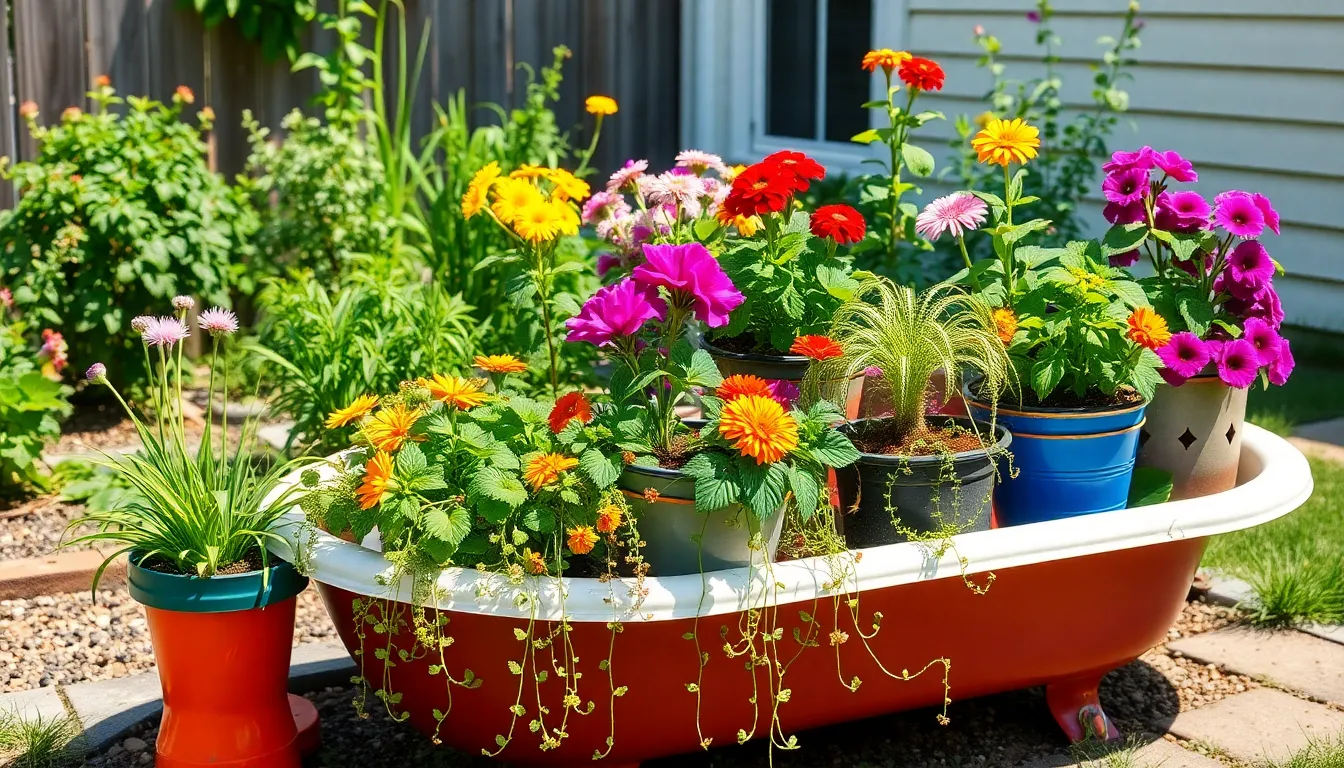
Our everyday household items offer incredible potential as unique garden containers when we shift our perspective beyond their original purpose. Research shows that upcycling household objects into planters not only reduces landfill waste but also adds distinctive character to outdoor spaces.
Use Boots and Shoes as Quirky Planters
Rain boots transform into delightful planters that bring whimsical charm to any garden space. Their deep interior accommodates root systems perfectly while their weatherproof material withstands outdoor conditions. We recommend selecting sturdy leather shoes or rubber boots that can handle soil weight and moisture exposure.
Creating proper drainage becomes essential for successful boot planters. Simply poke several holes through the soles using a drill or sharp tool to prevent water accumulation. Fill boots with quality potting mix and plant cheerful flowers like pansies or trailing herbs such as thyme.
Arranging boot planters near entryways or along garden paths creates conversation starters. We’ve found that colorful rain boots work especially well for children’s garden areas while vintage leather boots suit rustic or farmhouse garden themes.
Transform Kitchen Colanders into Hanging Baskets
Kitchen colanders already feature built-in drainage that makes them perfect hanging basket alternatives. Their perforated design eliminates waterlogging concerns while their handles or hooks provide convenient hanging points. We prefer metal colanders for durability though plastic versions work for lighter plantings.
Painting colanders enhances their decorative appeal without compromising functionality. Choose outdoor spray paint in colors that complement your garden scheme or leave them natural for industrial charm. Fill with lightweight potting mix and select trailing plants like petunias, ivy, or cherry tomatoes.
Positioning colander baskets at varying heights creates visual interest throughout garden spaces. We suggest hanging them from shepherd’s hooks, pergola beams, or sturdy tree branches where they’ll receive appropriate light for their plant selections.
Convert Bathtubs into Raised Garden Beds
Old bathtubs excel as raised garden beds due to their substantial size and durable construction. Their waterproof material protects soil from ground contamination while their depth supports extensive root development for vegetables, herbs, or flowering plants. Research indicates that bathtub gardens are particularly popular for urban gardening and small-space answers.
Installing bathtubs on legs or wheels improves accessibility and drainage performance. We recommend drilling drainage holes in the bottom and adding a layer of gravel before filling with quality garden soil. This setup prevents water accumulation while maintaining proper soil moisture levels.
Growing vegetables in bathtub gardens yields impressive harvests in compact areas. Their large capacity supports multiple plantings such as tomatoes, peppers, and herbs while their elevated position reduces bending and back strain during maintenance. We’ve observed that bathtub gardens work exceptionally well for apartment balconies and small urban yards.
Create Garden Art from Discarded Materials
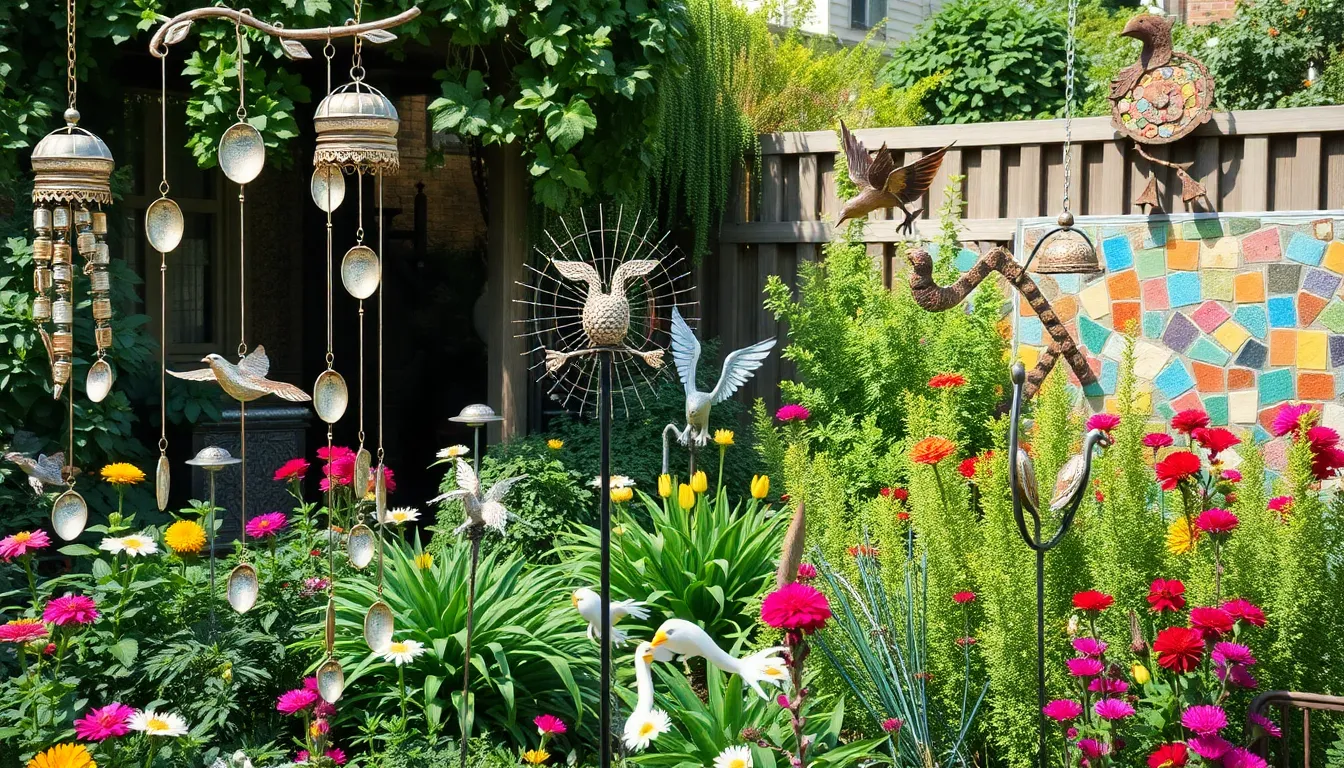
Garden spaces come alive when we transform forgotten items into captivating artistic displays. Converting discarded materials into garden art reduces waste while adding personalized touches that reflect our creativity and environmental consciousness.
Make Wind Chimes from Recycled Items
Metal objects create the most melodious wind chimes when we repurpose old spoons, washers, or glass bottles. Drilling small holes near the top of each item allows us to attach them to a metal rod or wooden dowel using fishing line or thin wire. Glass bottles produce deeper tones when we cut them at varying lengths, while metal spoons offer bright, tinkling sounds that dance with every breeze.
Wooden pieces combined with sea glass generate unique acoustic experiences that blend natural materials beautifully. We can sand weathered wood scraps smooth and pair them with collected sea glass or broken ceramic pieces for a coastal-inspired chime. Threading these materials at different heights creates layered sounds that change with wind intensity, adding both visual interest and auditory pleasure to our outdoor spaces.
Build Garden Sculptures from Metal Scraps
Welding or bolting metal scraps together creates striking animal figures that serve as focal points throughout our gardens. Old pipes, rebar pieces, and discarded metal sheets transform into birds, butterflies, or abstract creatures when we arrange them thoughtfully. These sculptures develop beautiful patina over time, naturally integrating with surrounding plants and industry features.
Geometric shapes like spheres, cubes, or pyramids add modern touches to traditional garden settings when constructed from various metal scraps. We can create these forms by bending wire mesh into desired shapes and filling them with smaller metal pieces, or by welding flat metal pieces into three-dimensional structures. Painting these sculptures with weather-resistant finishes allows us to coordinate colors with seasonal plantings or garden themes.
Design Decorative Borders with Broken Tiles
Arranging broken tiles into mosaic patterns creates colorful, durable borders that define garden beds and pathways effectively. We can collect tiles from renovation projects, thrift stores, or broken household ceramics to build extensive collections of colors and textures. Grouting these pieces together ensures longevity while allowing creative expression through pattern design and color placement.
Tile mosaic pathways add visual interest while providing practical walking surfaces that withstand weather and foot traffic. Creating these pathways involves laying broken tiles in sand or concrete bases, then filling gaps with grout or small pebbles. We can incorporate meaningful objects like broken china from family heirlooms or colorful glass pieces to create personalized garden features that tell our unique stories while serving functional purposes.
Develop Water Features Using Recycled Components
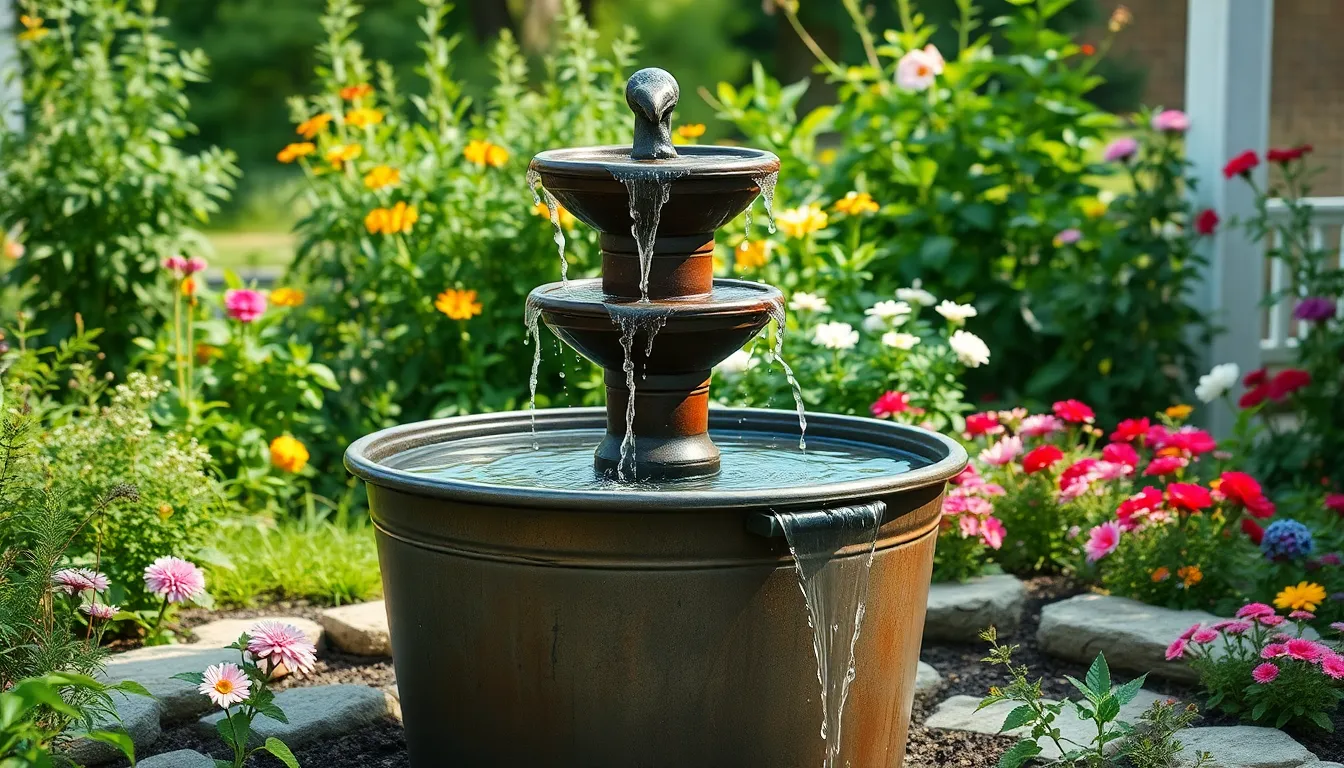
Water features transform ordinary gardens into tranquil sanctuaries while recycled components make these projects both eco-friendly and budget-conscious. We’ll explore three practical approaches that salvage materials destined for landfills into functional water elements.
Construct Fountains from Old Buckets
Old metal or plastic buckets become stunning cascading fountains with minimal effort and maximum impact. We position buckets at varying heights to create a natural water flow, drilling strategic holes to connect each level with a simple pump system.
Materials we typically use:
- 3-4 buckets of different sizes
- Small water pump (100-200 GPH)
- Flexible tubing
- Drill with various bit sizes
Stacking creates the most dramatic effect, with water pumped from the bottom reservoir back to the topmost bucket. We ensure each bucket has proper drainage holes positioned to create gentle spillover effects. The continuous circulation produces soothing sounds while attracting beneficial wildlife to our garden spaces.
Visual appeal increases when we paint buckets in weather-resistant colors or leave metal versions to develop natural patina. These fountains typically cost under $50 to construct compared to $200-500 for store-bought alternatives.
Build Pond Filters with Plastic Containers
Large plastic storage tubs and containers excel as pond filtration systems that keep water crystal clear naturally. We transform these discarded items into multi-stage filters using readily available materials.
Filter layers we recommend:
- Coarse gravel (bottom layer)
- Activated charcoal (middle layer)
- Fine filter sponges (top layer)
- Biological media for beneficial bacteria
Container modifications involve cutting inlet and outlet holes at exact heights to ensure proper water flow through all filtration stages. We position the pump to draw pond water through the bottom inlet, forcing it upward through each cleaning layer before returning to the pond.
This DIY approach costs approximately 60% less than commercial pond filters while providing comparable filtration performance. Maintenance becomes simple since we can easily access and replace individual filter components as needed.
Create Irrigation Systems from PVC Pipes
PVC pipes from plumbing projects transform into precision irrigation networks that deliver water exactly where plants need it most. We design these systems to reduce water waste by up to 40% compared to traditional sprinkler methods.
Basic system components:
- Various PVC pipe diameters
- T-joints and elbow connectors
- Adjustable drip emitters
- Timer-controlled valve system
Customization allows us to create targeted watering zones for different plant requirements. We drill holes at exact intervals along the main lines, installing drip emitters that control flow rates for individual plants or garden sections.
Installation involves burying main lines 2-3 inches deep with above-ground distribution points near plant root zones. These systems operate efficiently for 5-10 years with minimal maintenance, making them ideal long-term garden investments.
Programming timers ensures consistent watering schedules while we’re away, supporting healthy plant growth without constant manual attention. The modular design allows easy expansion as our gardens grow and evolve over time.
Conclusion
Garden upcycling opens endless possibilities for creating beautiful outdoor spaces while making a positive environmental impact. We’ve shown you how everyday items can become extraordinary garden features that reflect your personal style and commitment to sustainability.
The projects we’ve explored prove that creativity knows no bounds when it comes to repurposing materials. From tire planters to pallet storage answers and plastic bottle irrigation systems every discarded item holds potential for garden transformation.
By embracing these upcycling techniques you’ll not only reduce waste and save money but also create a truly unique garden sanctuary. Start small with one project and watch as your outdoor space transforms into an eco-friendly haven that tells your story through repurposed treasures.
Frequently Asked Questions
What is garden upcycling and why should I consider it?
Garden upcycling is the practice of repurposing old household items into functional and decorative garden elements instead of throwing them away. It promotes sustainability by reducing waste, saves money by avoiding new purchases, and allows you to create personalized outdoor spaces that reflect your unique style while supporting eco-friendly living practices.
What are some easy garden upcycling projects for beginners?
Beginner-friendly projects include turning old boots into flower pots, using kitchen colanders as hanging planters, and converting plastic bottles into self-watering containers. These projects require minimal tools and skills while providing immediate visual impact and functional benefits for your garden space.
How can I upcycle old tires for my garden?
Old tires make excellent planters when stacked vertically for herb gardens or painted for visual appeal. You can also convert them into garden swings by following proper safety installation guidelines. Ensure proper drainage when using tires as planters by drilling holes in the bottom.
What can I do with wooden pallets in my garden?
Wooden pallets are incredibly versatile for garden projects. Create vertical gardens for small spaces, build compost bins with excellent airflow, construct tool storage racks, or transform them into potting benches. Always sand and treat pallets before use to ensure safety and longevity.
How do I create self-watering planters from plastic bottles?
Cut a plastic bottle in half, invert the top portion into the bottom, thread a string through the cap into the water reservoir below, and fill with soil. This creates a consistent watering system that draws moisture up through the string, perfect for maintaining plant hydration.
Can old furniture be used in garden spaces?
Absolutely! Transform old chairs into unique planter stands, convert dresser drawers into multi-level gardens, and repurpose tables as functional potting stations. Ensure outdoor furniture is properly treated for weather resistance and add drainage holes where needed for plant containers.
What household items make good garden containers?
Many household items work as planters: old boots and shoes (with drainage holes), colanders as hanging baskets, bathtubs as raised beds, and even teapots for herbs. The key is ensuring proper drainage and choosing container sizes appropriate for your plants’ root systems.
How can I create garden art from recycled materials?
Make wind chimes from metal spoons and glass bottles, build sculptures from metal scraps, or create decorative borders using broken tiles in mosaic patterns. These projects add personality to your garden while reducing waste and providing unique focal points that reflect your creativity.
What are some DIY water feature ideas using recycled materials?
Create fountains from old buckets with simple pump systems, build pond filters using plastic containers, or design irrigation systems from PVC pipes. These features enhance garden aesthetics while promoting water conservation through efficient design and recycling of materials that would otherwise be discarded.

